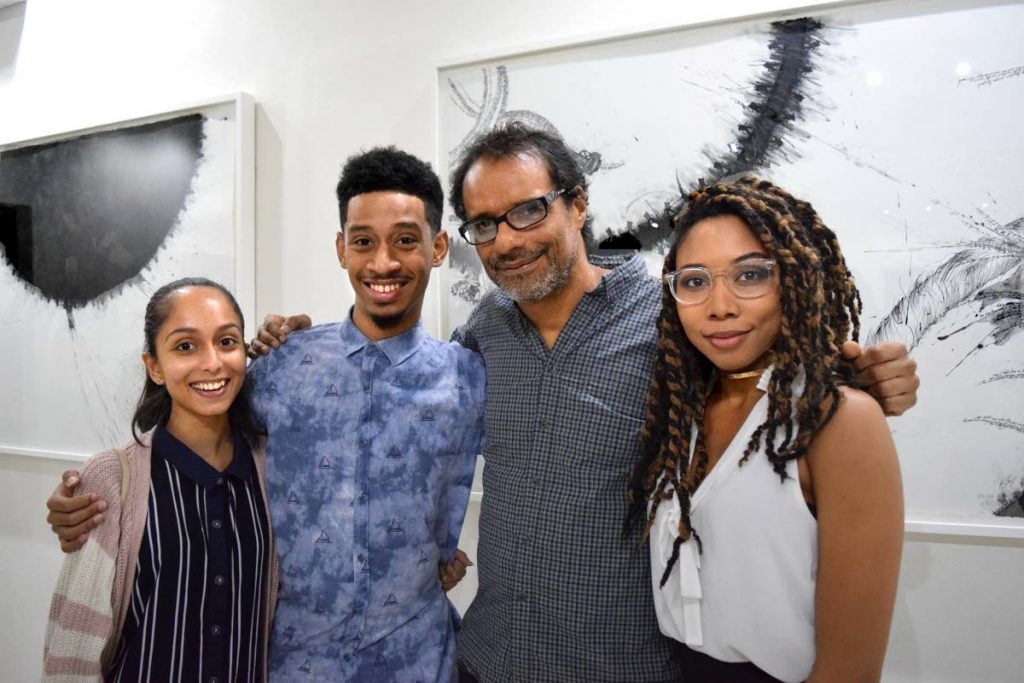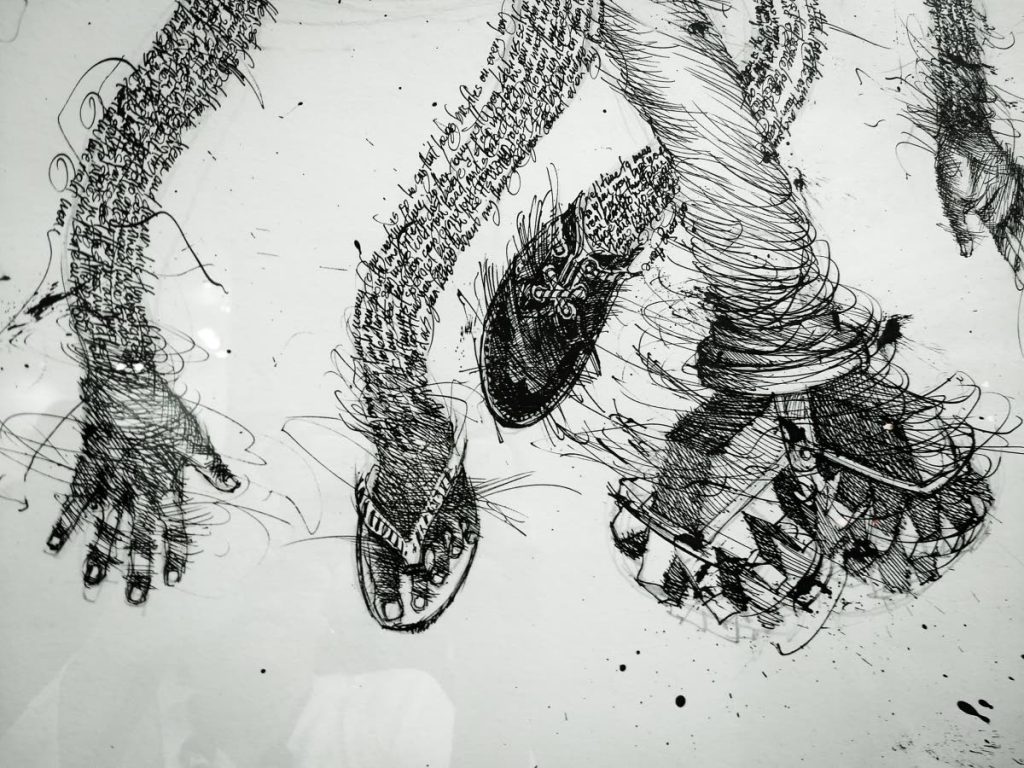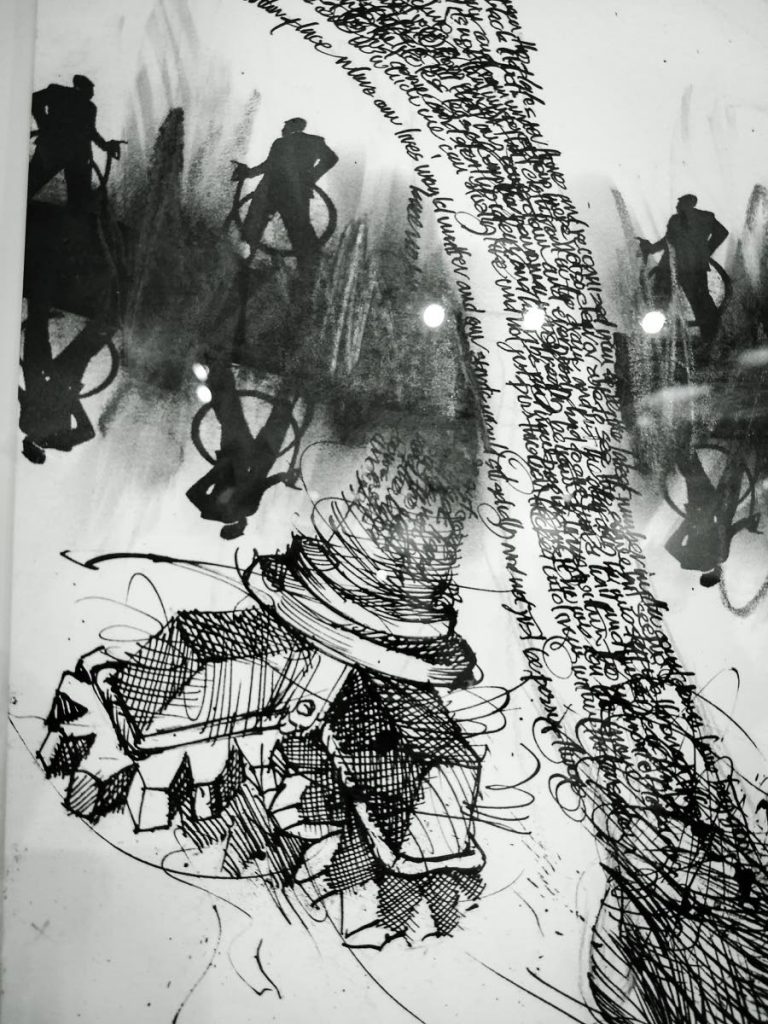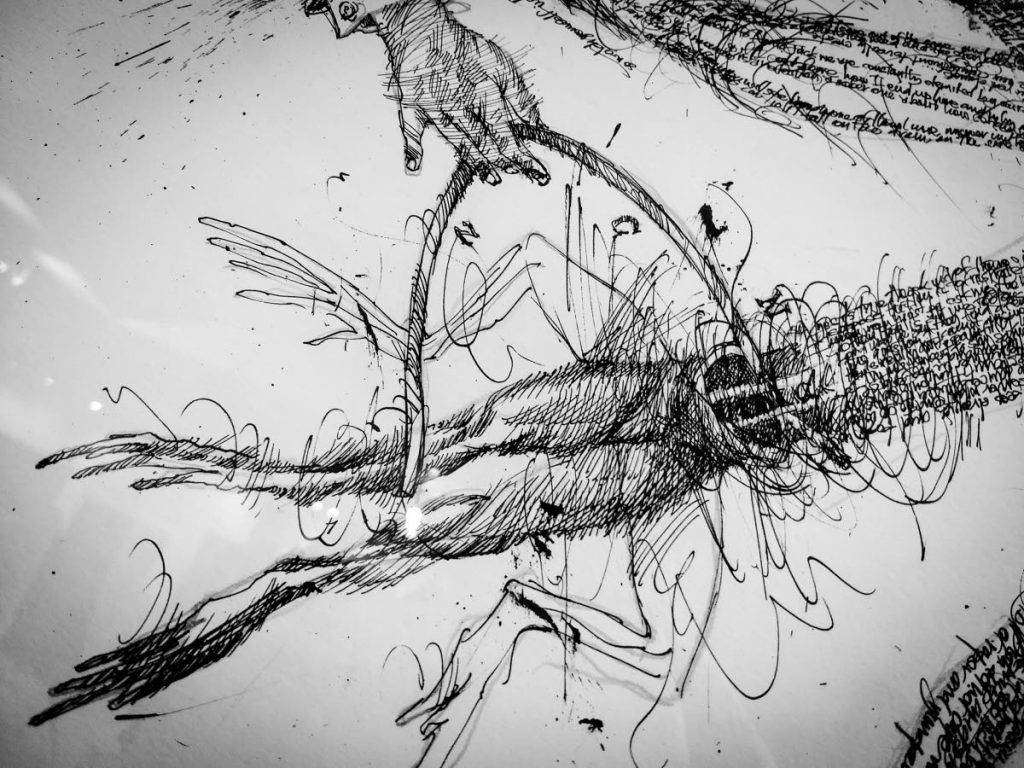Tie-up Things

CHRISTOPHER Cozier is a contemporary artist whose current show, Occupation as Process, opened at the Y Art Gallery on March 19, and runs until April 7. His work often looks at contradictions of Caribbean culture and society, and how these relate to global issues of identity, power relationships and fragmented, mutated or frustrated development. Cozier recently was awarded a residency from the Davidoff Art Initiative (DAI), which he will take up in Germany later this year. Here, SHEREEN ALI asks Christopher Cozier questions about some of the work now on show.

The drawings Tie-Up Things and More Tie-Up Things are a fascinating swirl of gears, feet, hands, gas pumps, and what looks like the exploding viscera of a crapaud (or a half-man, half-crapaud) figure created through ink words, while a mysterious "jacketed" corporate hand seems to be manipulating the whole. What were some of the ideas propelling you to create this piece?
These started with the studies for The Arrest: Hands Up, Hands Out – a lightbox installation done for the Betsy Hotel, during Miami Art Basel, in 2013. I was thinking about petroleum as a Trojan horse or gift from the Greeks, and the plight of Laocoön. (In Greek mythology, Laocoön was a Trojan priest who was attacked, with his two sons, by giant serpents sent by the gods. In Virgil's Aeneid, Laocoön was killed after trying to expose the ruse of the Trojan horse by striking it with a spear.) So The Arrest evolved into the Gas Men installation and a Part 2 of The Arrest called Dark Circles at the Betsy in 2015.

These particular works (Tie-Up Things and More Tie-Up Things) are from the Entanglements series previously shown in Costa Rica and Munich. The legs of these creatures become hands, feet, pumps, silicone drill bit heads, excavators, and office ladies’ shoes. The text is a rant – like in the Russian author Fyodor Dostoevsky's existentialist novel Notes from Underground. Even though this improvisational text or free-styling is in Black & White, the next lines of text obscure previous ones, so it vanishes as fast as it appears.
In a 2015 interview with independent producer/arts writer Sasha Dees, I remember saying that this work is about entanglements… about the crawly creatures that you never see or that you never see the whole of…they are fast, slithering, crawling and hiding in a corner between spaces…You second-guess yourself – are they there? Did you just see that? Over there under the table…under the bed? Things that bite and that hide in those in-between spaces. Things you see as you walk or drive along or that you see on the news, out the window and doubt yourself…did I just see that?

The character of Laocoön fascinated me. It transferred to images of victim’s feet, gas hoses and legs, the gift from the Greeks, and the gift of oil. Why do all the oil economies have so much violence? What’s the connection? Maybe that was what the world was also like in the era of sugar – that ugly, violent moment in the past when the Caribbean was an important industrial site; the pipes drilling deep underground between the plates to release the oil and gas. I think of the entanglements.
How messed up/mixed up/ “tie-up” do you think we as Trinidadians are? What are we tied up by – external factors beyond our control, or ourselves (i.e. how we react to things, how we act or behave)?
(We’re messed up by) the breakdown of oil economies...like (what’s happening in) Caracas or Lagos. The frog refers to the Galvani experiment of connecting electrodes to the dead frog, creating a convulsion of some kind, perhaps defining our electoral behaviour when the soca motorcades crawl across the landscape.
Are the written words in works 1, 2, 3 and 4 sense or gibberish to produce a visual texture? How long did that take to execute?
I am writing very clear sentences and thoughts, improvisationally and indiscreetly...there is a lot of repetition – in a call-and-response kind of way. Some took a week or two, some just one night. Some of the most intense ones were done on residencies abroad.
The ink drawings and lines in works 1, 2 & 3 are very expressive. Do you draw in pencil first, carefully planning your compositions, or go brave with the ink and see what happens? Share with us a little of your process.
You can see the pencil lines – they are mostly compositional mappings. I draw directly with an old-fashioned dipping quill-like pen, Speedball 6C nib is my favourite, and a bottle of Indian ink. I usually do the drawing/writing with two pens: one new one, and then I shift to the older one that’s worn down, as sometimes it sticks and causes splatters, which causes shifts.
Work 4 seems to comment on Trinidad's tangled involvement with oil investors/exploiters. Indeed one interpretation of Dark Circles Study is that oil has truly messed up Trinidad, that it is a huge blot on our history and souls. Any response to this interpretation?
I was thinking about the whole planet – a dead planet form. Gas Men was about the wars for resources – so these titan-like figures with nozzles are squaring off, like in a B-movie spectacle.
What audience do you have in mind when you make such critical works that don't necessarily blend in prettily with the typical Trini house decor?
Trinidadians are very educated people, comparatively, very visually aware and tuned in to what they see, as tuned in as any audience, anywhere in the world. The anti-contemporary posture and carping that pops up every couple of years is just class warfare and an attempt by certain artists (or the people who sell and buy their work) to protect their status and the direction of investment.
How do you defend conceptual art that may be minimalist and more about ideas than about a simple, pleasing, easily understood aesthetic object?
I am not sure that ideas are not pleasing or not visual; not sure that that is the binary. We need to face up to our reality rather than run from it, visually. If we find our way through the current challenges, we have to be as courageous as past generations had to be. We need art that reflects our willingness to deal with the world as it is around us now, so we can grapple with it honestly and find our way. We need art that celebrates the shape of our current imagination and resourcefulness and says that we are searching – figuring our way– not running from it or in denial or seeking validation by hiding behind and re-enacting past gestures.
WHAT: Christopher Cozier: Occupation as Process
WHERE: Y Art Gallery, 26 Taylor Street, Woodbrook
DATES/HOURS: March 9 – April 7, Mon-Fri 9 am-5 pm
CONTACTS: Call the Gallery at (868) 628-4165
Christopher Cozier blog: http://christophercozier.blogspot.com/
Alice Yard: www.aliceyard.org

Comments
"Tie-up Things"